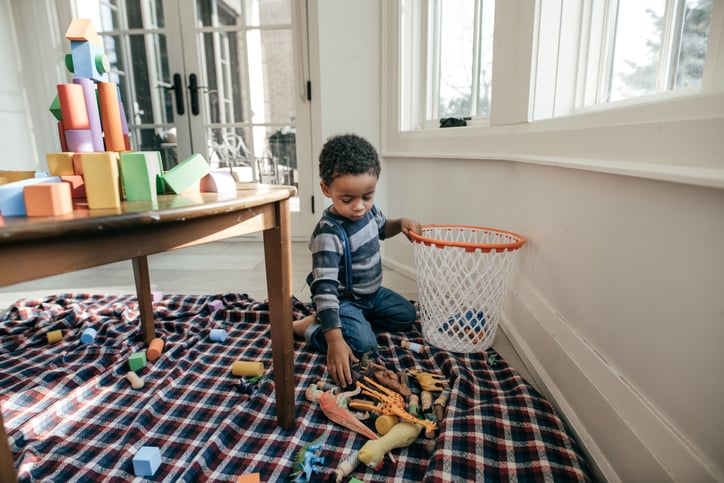What Is Discrete Trial Training?
Many children with autism do not learn skills spontaneously and may need extra help and specific teaching to learn things that may come naturally to their typically developing peers. They often need highly structured, repetitive instruction that requires them to actively engage with their environment to learn new skills. This is where Discrete Trial Training (DTT) can help.
In 1964, Dr. Ivar Lovaas and his colleagues at UCLA began the first treatment study of behavioral interventions for children with autism spectrum disorder (ASD). Dr. Lovaas and his team used very specific procedures to teach the children in their studies, which they called discrete trial training or DTT. Instead of teaching an entire skill at once, they broke it down into smaller steps and “built up” the skill using discrete trials to teach each step one at a time. These trials were often repeated several times, and the child being taught was rewarded for responding correctly.
Why Discrete Trial Training?
Discrete trial training’s consistent, predictable nature makes it a popular choice for working with children with autism. The built-in reinforcement provides autistic children with additional motivation for learning and social interaction, which may not come naturally to them.
It was previously thought that DTT could only take place in a one-on-one setting at a table with no distractions. While many DTT programs are set up this way, we now know that DTT can be done in multiple environments, such as classrooms, homes, and even in the community. In fact, when DTT is implemented in different settings, generalization of the targeted skills is much more likely to happen.
When done correctly and devoting a sufficient amount of time to these discrete trials, DTT has proven extremely effective.

What Is a Discrete Trial?
The discrete trial is divided into three parts. These three core parts are often referred to as the ABC progression, which stands for the Antecedent, what happens before the behavior; the Behavior, how the student responds, and the Consequence, what happens as a result of the student’s behavior or response.
A. The Antecedent Stimulus
The first part of the discrete trial is the antecedent stimulus, also known as the discriminative stimulus (Sd), or the cue that you give a child to perform the target behavior. You can also think of this as a direction, instruction, or command. This cue should be clear, concise, and consistent and given only once before reinforcement is given.
B. The Behavior
The second part of a discrete trial is the behavior or response that the child gives. There are three kinds of responses a child can have: A correct response, an incorrect response, or no response at all.
C. The Consequence
The third part of the discrete trial is called the consequence. The consequence or result is what happens directly after the child’s response. A consequence can be either negative or positively reinforcing. A positively reinforcing consequence increases the likelihood of a correct behavior happening again when the child is asked to answer. A negative consequence decreases the likelihood of the wrong response happening again when the child is presented with the same instruction. A negative consequence could be as simple as not looking at the child, or not reacting with “good job” or other positive feedback.
Here are some examples:
How Is DTT Implemented?
There are generally nine steps to implementing DTT. These include:
Deciding what to teach:
Teachers first discuss the planned use of DTT for a particular skill the child needs to learn with other team members, especially the parents, family members, or caregivers, and refine it if needed. The targeted skill should have a clear beginning, middle, and end that can be broken down into small steps. They should also get the parents’ input on what types of reinforcers will be most effective with the student.Breaking the skill down into teachable steps:
Teachers then complete a task analysis of the skill by identifying each step and listing the steps in sequential order from start to finish.
Setting up the data collection system:
Once the skill has been broken down, teachers select data sheets specifically designed for the skill being taught.Designating location(s):
Teachers also generate a list of possible locations where the teaching can take place, i.e. in the classroom, in the cafeteria, at home, etc.Gathering materials:
Now it is time for teachers to gather the materials that will be used during the teaching. These could include binders for data collection, a preference list or menu based on preference assessment, a variety of tangible reinforcers, and instructional materials.Delivering the trials:
Teachers may need to assist the child to transition to the location where the teaching will take place before presenting the discrete trials for the selected skill(s). A two-minute warning may be helpful or other cues that are meaningful and motivating.Massed trial teaching:
This simply means that the adult working with the child will repeat the same learning trial several times in a row to make sure that the learner is successful multiple times at whatever step of the skill that is being taught.Conducting discrimination training:
Once the student responds successfully multiple times, the teacher will present the target stimulus as usual but also present an additional stimulus or distracter in the margin. They then present the instruction again, elicit the response, and reinforce the response.Reviewing and modifying:
Teachers will frequently review the child's progress and modify the program to reflect the progress the student has made by changing steps (either to higher or lower levels) as needed. They will also practice the mastered skills in maintenance trials.
Discrete Trial Training – The Next Steps
Children on the autism spectrum often have difficulty generalizing or transferring the skills they learned from one setting to another, so it is important to promote the generalization of skills the child has mastered. Using the learned skills in natural environments is the ultimate goal of DTT. For example, if a child learned how to identify colors using discrete trial training at school, it will be important to ask the child’s family how the child is doing generalizing this skill of identifying colors at home.
Children with autism often do not learn academic, social, and functional skills spontaneously. They may need highly structured, repetitive instruction that requires them to actively engage with their environment to learn new skills.
Discrete trial training (DTT) can help by breaking skills down into small, teachable steps that can be repeated, and rewarding the successful completion of small steps to motivate the child and reinforce desired behaviors or responses.
DTT has helped many autistic children successfully learn and generalize new skills across different settings and could help your child or student to make the needed progress, too.
Resources
Bogin, J., Sullivan, L., & Rogers, S. (2011). Discrete trial training (DTT): Online training module. (Sacramento, CA: National Professional Development Center on Autism Spectrum Disorders, M.I.N.D. Institute, University of California at Davis Medical School). In Ohio Center for Autism and Low Incidence (OCALI), Autism Internet Modules, www.autisminternetmodules.org. Columbus, OH: OCALI.
Have you used DTT with your child or student? What were your experiences? Please share with us in the comments section below.
We hope you enjoyed the information in this article. STAGES® Learning also offers free downloadable resources to support teaching and learning with individuals with autism. Start with our free Picture Noun Cards and see our collection of other downloadable resources here!

Ymkje Wideman-van der Laan
Ymkje Wideman-van der Laan is an author, public speaker, and Certified Autism Resource Specialist from the Netherlands. After working abroad as a teacher and humanitarian for 25 years, she moved to the US in 2006 and assumed the care of her then 6-month-old grandson, Logan. There were signs of autism at an early age, and the diagnosis became official in 2009. She has been his advocate and passionate about promoting autism awareness and acceptance ever since. Logan is the inspiration behind the Autism Is...? (tinyurl.com/5aj73ydd) series of children’s books she initially wrote for him and later published. Ymkje currently lives in California with her now 15-year-old grandson, and besides writing, presents autism training workshops for early childhood educators, parents, and caregivers. You can read more about her story in her newly released book, Autism on a Shoestring Budget, [Early] Intervention Made Easier (https://tinyurl.com/ysxhxbmf). For more information, you can visit www.autism-is.com, www.facebook.com/AutismIs, and/or contact her at autismisbooks@gmail.com.




